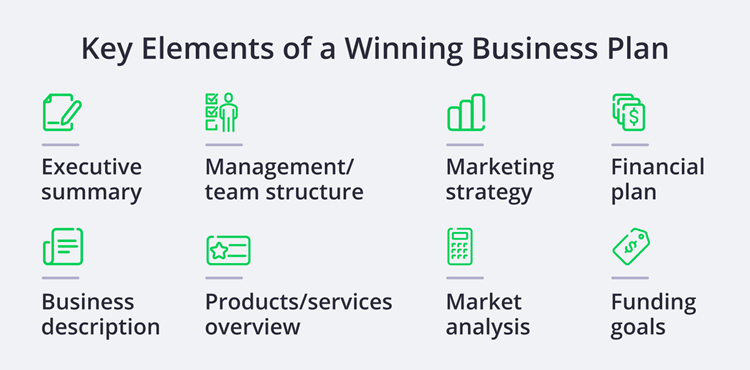How to protect your tech company from 6 common startup risks

Launching a new technology company is difficult even for the most experienced entrepreneurs. It’s no surprise that new businesses often fail. Anything from insufficient cash flow to poor team management can derail a promising technology startup.
Although you may be taking a risk, you’ll want to avoid these common startup business risks to improve your chances of success. Here are six types of risk that business owners should be aware of, and how you can protect your company from hidden threats.
1. Underestimating the competition or misjudging market demand
Successful start-ups often fill a gap in the market, yet many technology start-ups misjudge market demand and underestimate competitors.
That’s why it’s important to conduct market research as you launch your tech startup. This includes gathering and analyzing information about consumer preferences, competition, and trends in your industry.
You don’t necessarily need to hire a marketing consultant to do this. Here are some low-cost ways to reduce competitive risk by conducting your own market research:
- Search Google and read reports from reputable organizations to follow trends in your market
- Send an email survey to potential customers about their favorite product
- Use social media surveys to ask your target audience what they want from your brand
- Ask for feedback from customers
- Learn the competition and keep track of their marketing efforts, product updates, etc.
Based on the results of your market research, you may find that the market is crowded. It’s hard for tech startups in crowded markets to succeed, unless they really disrupt the space.
If you are facing a highly competitive or saturated market, look at alternatives in the market and reconsider your offer. Identify your niche early, and figure out what sets your startup apart from other companies in the industry.
2. Poor or poorly defined products or services
While you may know your proposition well, understanding who you are selling to is essential.
Tech startups need to clearly define what their product is, what it does, and who needs it. This is something that potential customers and investors need to know.
A good way to define your proposition is to start with a Minimum Viable Product (MVP). An MVP is a new product that is released with very basic features as a way to gauge user interest.
If the launch is successful, you can build on your MVP using what you learned from the initial release. If the product is not viable, you will have saved much needed capital.
One of the best startup tech tips is to write a business plan early. Even if you don’t need to raise capital, a business plan is still a good idea. It will act as a road map for your business moving forward.
Your business plan should include:
- Executive summary
- A description of your business
- A list of your products and services
- What sets you apart from the competition
- Market research/SWOT analysis
- Marketing strategy
- Business model, management and team structure
- Financial plan
- Funding goals (if any)
It can be tempting for new businesses to rush a product to market. You need to resist the urge and take your time to develop a product. Product quality can make or break your company’s reputation – and a poor quality product could even lead to litigation.
You may want to consider professional liability insurance if your new business provides a service. Also known as errors and omissions insurance, this coverage will protect you against claims of negligence, mistakes and oversights.
To manage product development risk, you may consider product liability insurance. It protects against claims that your product has caused injury or property damage. This coverage is usually included as a rider with general liability insurance policies.

3. Cash flow problems
Running out of money is a huge risk for new businesses. More than 80% of small businesses fail due to cash flow problems.
Make sure you forecast your spending correctly to account for this risk. If your operating costs are higher than your budget allows, you will need to make adjustments.
Creating a financial plan in the early days of your tech startup is essential. Your financial plan should include the following information:
- Your total budget
- Operating costs (rent, wages, inventory, etc.)
- Cash flow and current income statements
- Capital raised
- Debts and loans
- Financial projections
The financial plan should be included in your business plan. If you seek funding, banks and venture capital firms will want to see your financial plan to understand why they need their money. Along with good accounting practices and careful record keeping, a detailed budget can go a long way.
In the early stages of a business, saving capital is key. Keep an emergency fund to cover unexpected expenses, and don’t rush to pay off debt. It’s better to pay off low interest loans slowly than to blow your entire budget in one payment.
4. Cyber threats
A data breach or cyber attack is a threat to any business. But tech startups that store or handle sensitive data are at even greater risk.
The costs of a data breach can be high. If your business is breached, you could take a big financial hit. Also, if you are blamed for a client data breach you could face an expensive lawsuit.
To protect your startup from cyber threats, consider getting cyber liability insurance. There are two types of cyber liability insurance: first party and third party.
First party cyber liability insurance protects your business if your own network or systems are affected. It helps cover costs such as:
- Customer notifications and credit/fraud monitoring services
- Investigate/remediate security vulnerabilities
- Public relations costs
Third party cyber liability insurance will cover the costs if a client sues you for a data breach in their business. It helps cover legal costs including:
- Attorney’s fees
- Settlements or awards
- Other court costs
5. Team troubles
Countless start-ups have failed because their team didn’t have the right experience, or they took advice from questionable sources. Your team members and managers are vital to the success of your startup, so be strategic when recruiting.
Surround yourself with people who have the talent and expertise to help grow and lead your company. Networking with successful startup founders and seeking feedback can help. If you’re starting your first company, find a veteran who can show you the ropes.
A directors and officers (D&O) insurance policy can also help you attract and retain the best leaders. D&O insurance protects your co-founders, board members, and officers if they make a decision on behalf of the company that results in financial loss.
Directors and officers insurance covers legal proceedings relating to:
- Funds mismanaged
- Employee complaints
- Claims of slander, libel, and copyright infringement
- Failure to follow company bylaws
- Regulatory compliance
To protect your business from lawsuits by your employees, you may also consider employment practices liability insurance. This can help pay for claims relating to:
- Benefits mismanaged
- Sexual harassment
- Wrong termination
- Differentiate
- Breach of employment contract
A common mistake among startup owners is asking a skeleton crew to do too much, or having you and your partners be too hands-on when it comes to every decision. Either way, important details can slip through the cracks.
Cross-train your team to ensure important information is not lost. Make sure someone takes a bird’s eye view to quickly spot potential problems.
6. Protection of intellectual property and other legal matters
New businesses can have a large amount of intellectual property. Information such as patents and product designs can be accidentally exposed if you work with subcontractors.
To legally protect your intellectual property, make sure you have a written subcontractor agreement that every subcontractor you work with needs to sign. It should include:
- Scope of work and payment details
- Non-competition and non-disclosure terms
- Ownership rights
- Warranty clause
- A harmless clause or agreement
- Insurance requirements
To protect your business against intellectual property theft or other crimes, you may want to consider fidelity bond insurance. This coverage comes in two forms: first party and third party.
First party fidelity bond insurance covers costs relating to:
- Employees stealing or stealing from your company
- Employee fraud against your company
- Impersonate employees that affect your company
Third party fidelity bond insurance will cover costs relating to:
- Theft of an employee by a client
- Employee fraud against client
- Employee impersonation that affects a client
New business owners may not be aware of all the risks and legal requirements for their company. It helps to find an attorney or other trusted advisor to provide legal advice on matters such as copyright infringement or customer injury.
If your company is involved in a lawsuit, having a general liability insurance policy can protect you from common situations such as:
- Damage to client’s property
- Client injuries
- Advertising injuries such as slander, libel, and copyright infringement
If you own or rent an office or company vehicles, your business may also benefit from commercial property insurance and commercial auto insurance.
It’s easy to get so focused on day-to-day operations that you forget about the potential risks to your new business. But successful businesses keep these common startup risks in mind as they develop their risk management strategy.
Whatever your risks, the right business insurance is an important part of an effective risk management strategy. With careful planning and the right protection, you can improve the odds of success for your technology startup.

